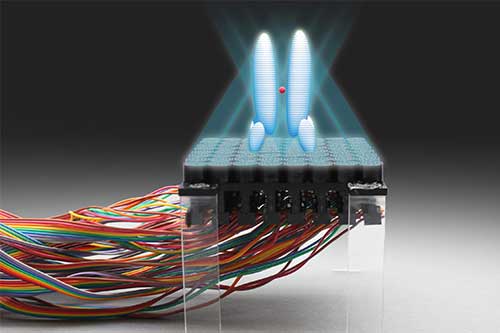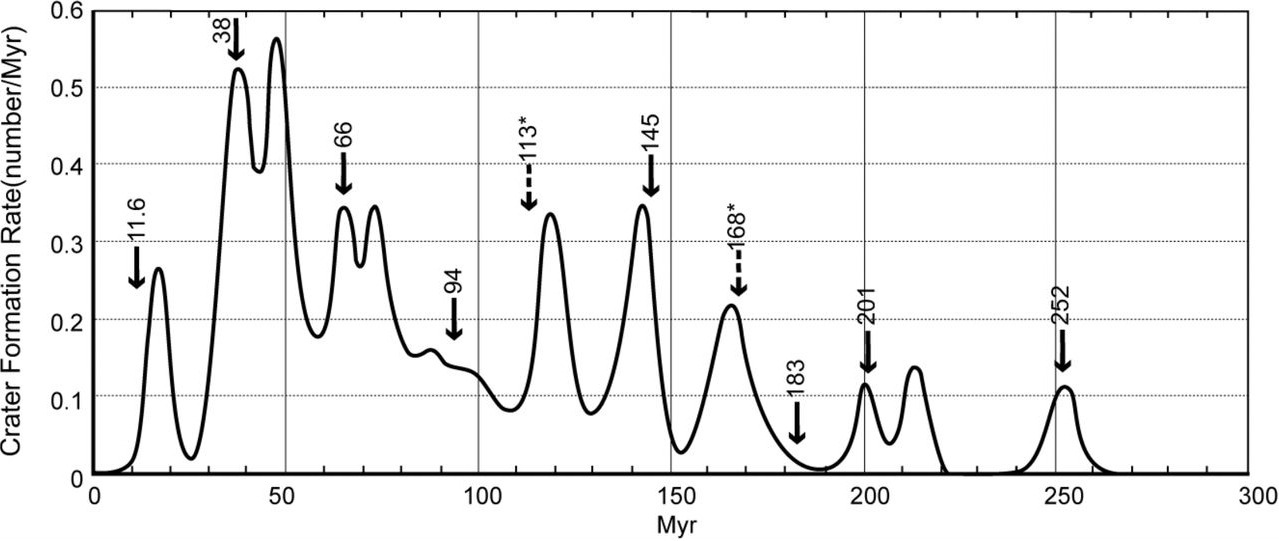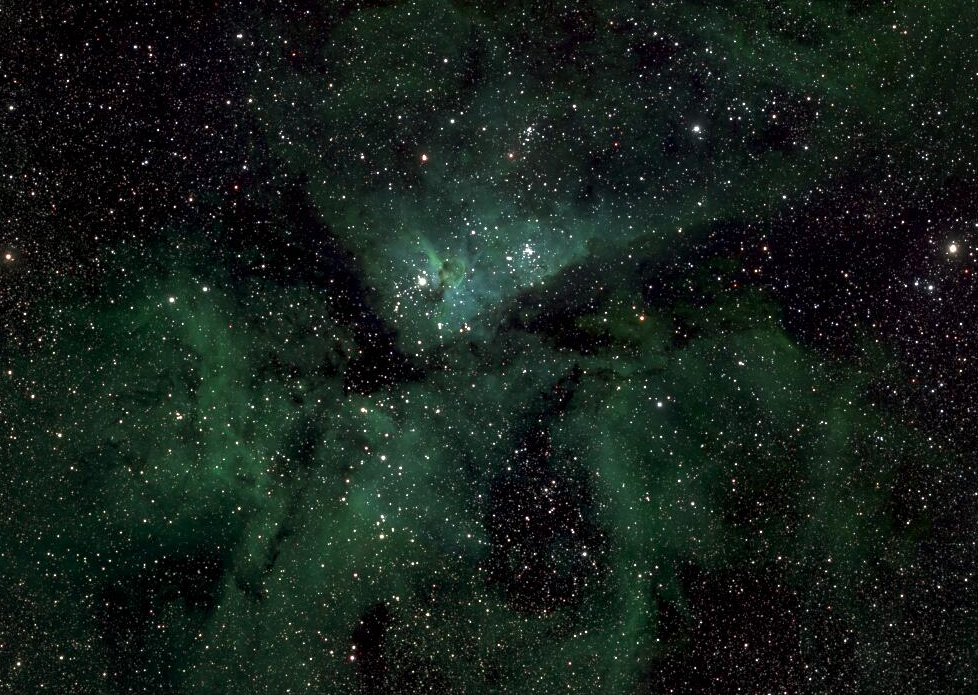
Three “accelerators on a chip” made of silicon. A shoebox-sized particle accelerator would use a series of these to boost the energy of electrons. (SLAC National Accelerator Laboratory)
The Gordon and Betty Moore Foundation has awarded $13.5 million to Stanford University for an international effort to build a working particle accelerator the size of a shoebox, based on an “accelerator on a chip” design, a novel technique using laser light to propel electrons through a series of glass chips, with the potential to revolutionize science, medicine, and other fields by dramatically shrinking the size and cost of particle accelerators.
“Can we do for particle accelerators what the microchip industry did for computers?” said SLAC physicist Joel England, an investigator with the 5-year project. “Making them much smaller and cheaper would democratize accelerators, potentially making them available to millions of people.”
SLAC National Accelerator Laboratory | $13.5M Moore Grant to Develop Working ‘Accelerator on a Chip’ Prototype
“Based on our proposed revolutionary design, this prototype could set the stage for a new generation of ‘tabletop’ accelerators, with unanticipated discoveries in biology and materials science and potential applications in security scanning, medical therapy and X-ray imaging,” said Robert L. Byer, a Stanford professor of applied physics and co-principal investigator for the project who has been working on the idea for 40 years.
The international effort to make a working prototype of the little accelerator was inspired by experiments led by scientists at the SLAC National Accelerator Laboratory (SLAC) and Stanford and, independently, at Friedrich-Alexander University Erlangen-Nuremberg (FAU) in Germany. Both teams demonstrated the potential for accelerating particles with lasers in papers published on the same day in 2013.
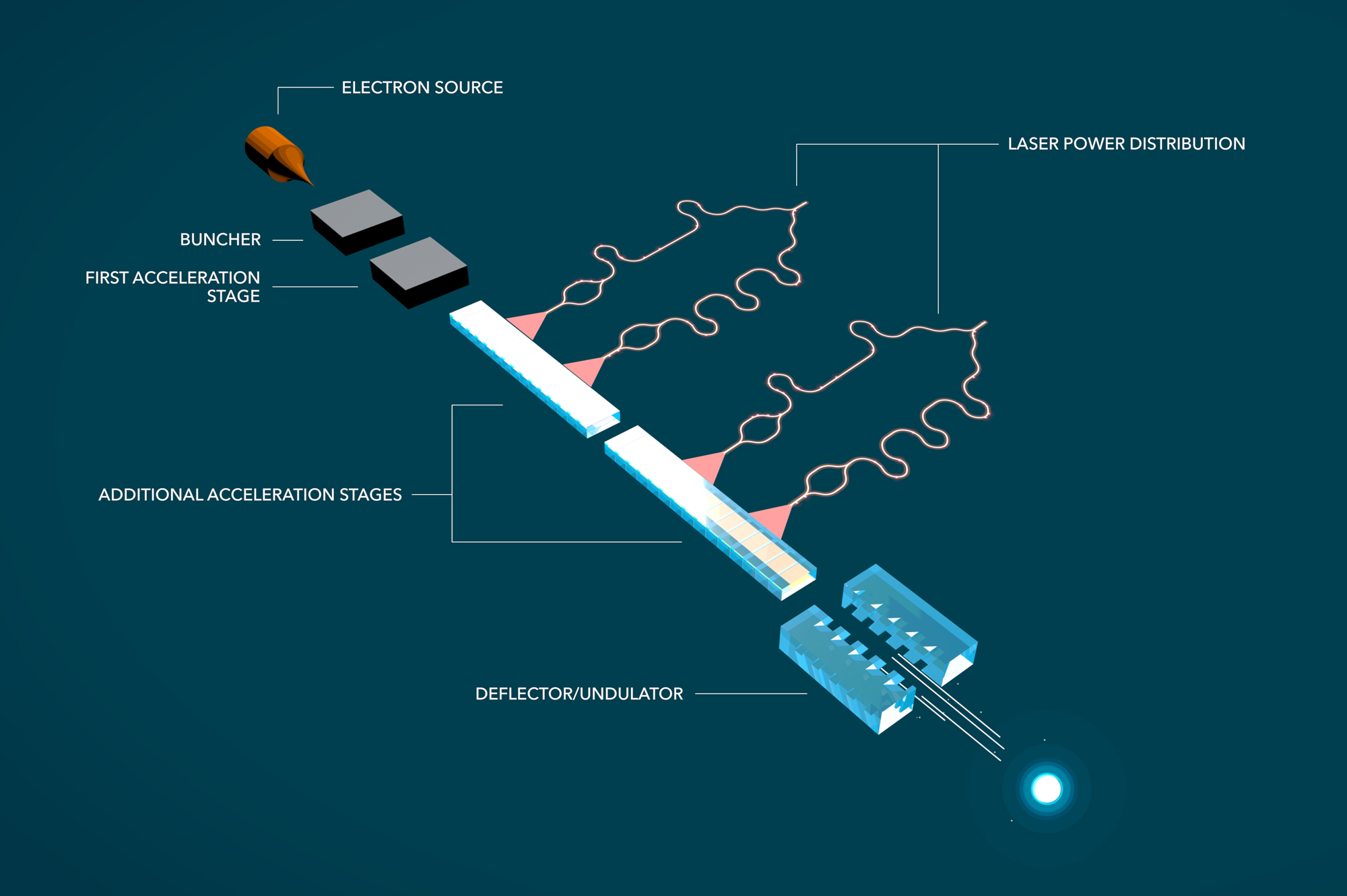
This diagram shows one possible configuration for the shoebox-sized particle accelerator prototype. The Stanford-led team will have to figure out the best way to distribute laser power among the the glass accelerating chips, generate and steer the electrons, shrink the diameter of the electron beam 1,000-fold, and a host of other technical details. (credit: SLAC National Accelerator Laboratory)
In the SLAC/Stanford experiments, published in Nature, electrons were first accelerated to nearly light speed in a SLAC accelerator test facility. At this point they were going about as fast as they can go, and any additional acceleration would boost their energy, not their speed.
The speeding electrons then entered a chip made of silica glass and traveled through a microscopic tunnel that had tiny ridges carved into its walls. Laser light shining on the chip interacted with those ridges and produced an electrical field that boosted the energy of the passing electrons.

LCLS, the world’s first hard X-ray free-electron laser, pushes science to new extremes with ultrabright, ultrashort pulses that capture atomic-scale snapshots in quadrillionths of a second. These images can reveal never-before-seen structures and properties in matter, and can be compiled to make movies of molecules in motion. (credit: SLAC)
In the experiments, the chip achieved an acceleration gradient, or energy boost over a given distance, roughly 10 times higher than the SLAC linear accelerator can provide. At full potential, this means the 2-mile-long Linac Coherent Light Source could be replaced with a series of accelerator chips 100 meters long — roughly the length of a football field.
In a parallel approach, experiments led by Peter Hommelhoff of FAU and published in Physical Review Letters demonstrated that a laser could also be used to accelerate lower-energy electrons that had not first been boosted to nearly light speed. Both results taken together open the door to a compact particle accelerator.
Challenges
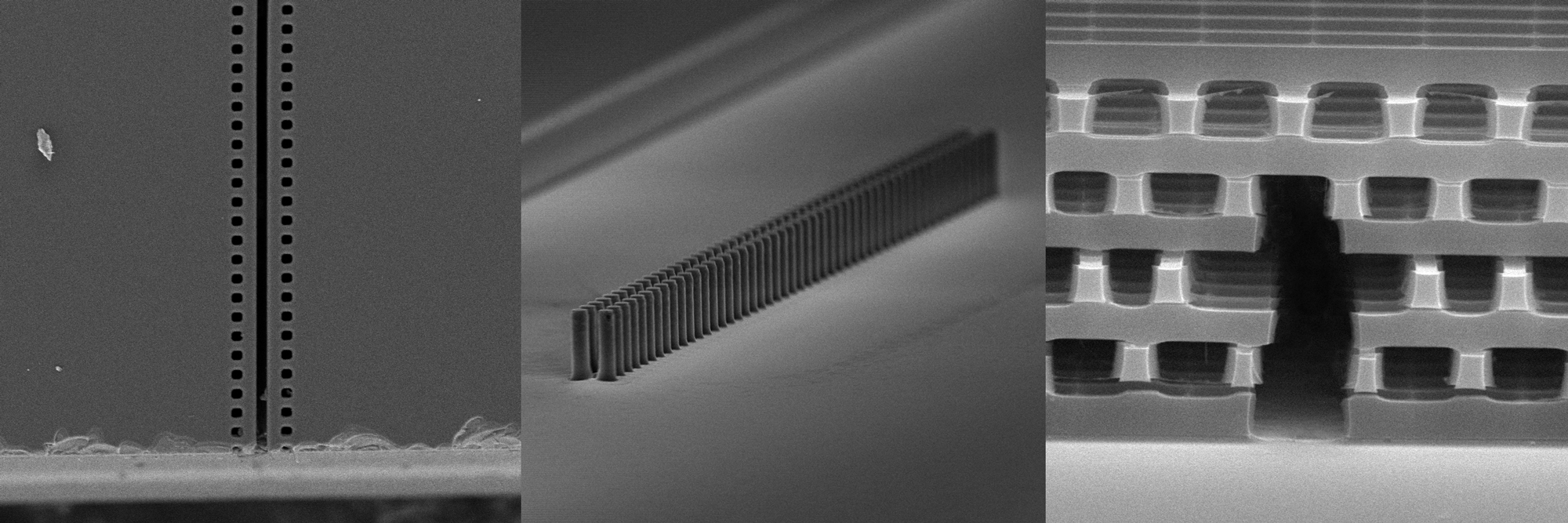
These microscopic images show some of the accelerator-on-a-chip designs being explored by the international collaboration. In each case, laser light shining on the chip boosts the energy of electrons traveling through it. (credit: Left and middle images: Andrew Ceballos, Stanford University, Right image: Chunghun Lee, SLAC)
For the past 75 years, particle accelerators have been an essential tool for physics, chemistry, biology and medicine, leading to multiple Nobel prize-winning discoveries. But without new technology to reduce the cost and size of high-energy accelerators, progress in particle physics and structural biology could stall.
The challenges of building the prototype accelerator are substantial, the scientists said. Demonstrating that a single chip works was an important step; now they must work out the optimal chip design and the best way to generate and steer electrons, distribute laser power among multiple chips and make electron beams that are 1,000 times smaller in diameter to go through the microscopic chip tunnels, among a host of other technical details.
The Stanford-led collaboration includes world-renowned experts in accelerator physics, laser physics, nanophotonics and nanofabrication. SLAC and two other national laboratories — Deutsches Elektronen-Synchrotron (DESY) in Germany and Paul Scherrer Institute in Switzerland — will contribute expertise and make their facilities available for experiments. In addition to FAU, five other universities are involved in the effort: University of California, Los Angeles, Purdue University, University of Hamburg, the Swiss Federal Institute of Technology in Lausanne (EPFL) and Technical University of Darmstadt.
Abstract of Demonstration of electron acceleration in a laser-driven dielectric microstructure
The enormous size and cost of current state-of-the-art accelerators based on conventional radio-frequency technology has spawned great interest in the development of new acceleration concepts that are more compact and economical. Micro-fabricated dielectric laser accelerators (DLAs) are an attractive approach, because such dielectric microstructures can support accelerating fields one to two orders of magnitude higher than can radio-frequency cavity-based accelerators. DLAs use commercial lasers as a power source, which are smaller and less expensive than the radio-frequency klystrons that power today’s accelerators. In addition, DLAs are fabricated via low-cost, lithographic techniques that can be used for mass production. However, despite several DLA structures having been proposed recently, no successful demonstration of acceleration in these structures has so far been shown. Here we report high-gradient (beyond 250 MeV m−1) acceleration of electrons in a DLA. Relativistic (60-MeV) electrons are energy-modulated over 563 ± 104 optical periods of a fused silica grating structure, powered by a 800-nm-wavelength mode-locked Ti:sapphire laser. The observed results are in agreement with analytical models and electrodynamic simulations. By comparison, conventional modern linear accelerators operate at gradients of 10–30 MeV m−1, and the first linear radio-frequency cavity accelerator was ten radio-frequency periods (one metre) long with a gradient of approximately 1.6 MeV m−1. Our results set the stage for the development of future multi-staged DLA devices composed of integrated on-chip systems. This would enable compact table-top accelerators on the MeV–GeV (106–109 eV) scale for security scanners and medical therapy, university-scale X-ray light sources for biological and materials research, and portable medical imaging devices, and would substantially reduce the size and cost of a future collider on the multi-TeV (1012 eV) scale.


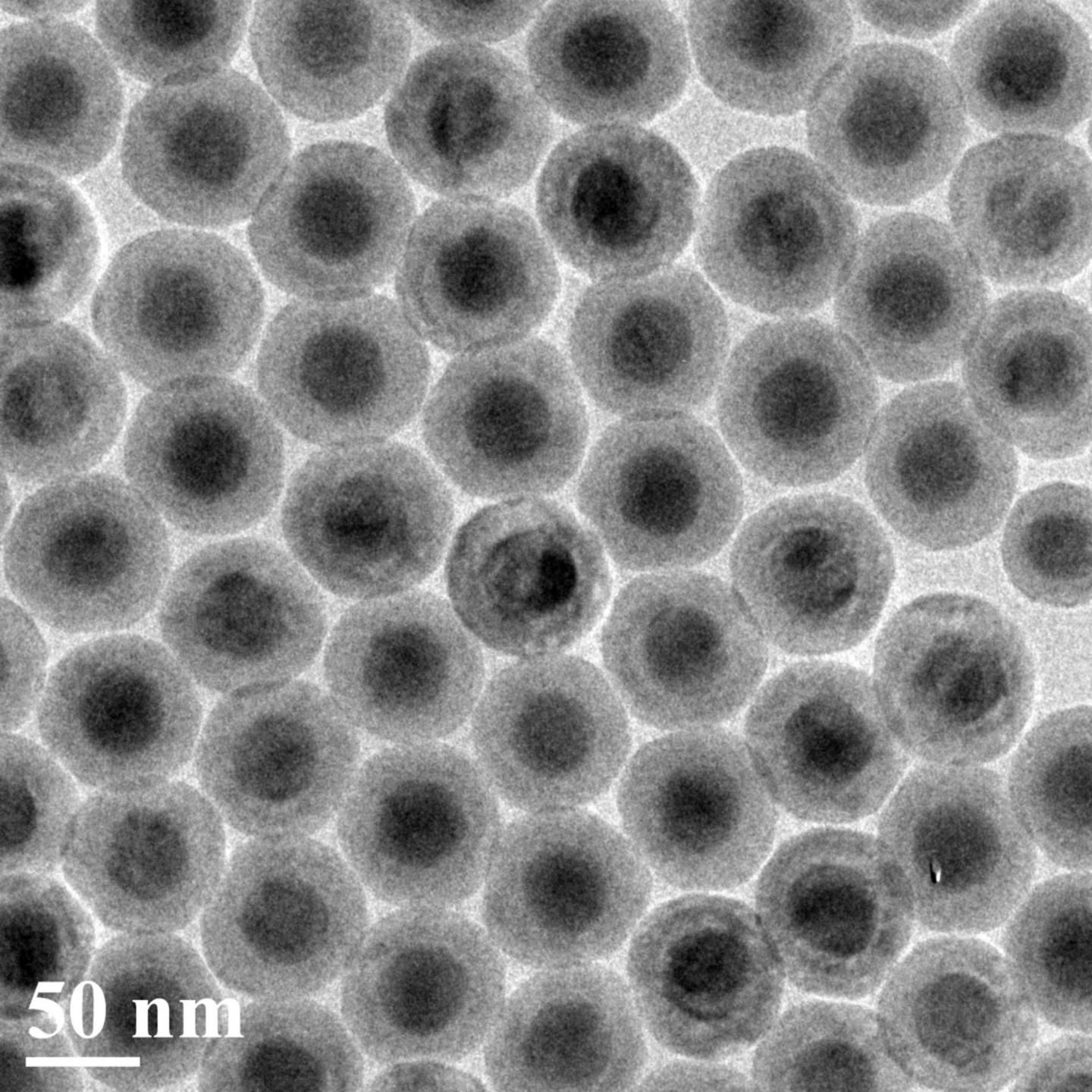

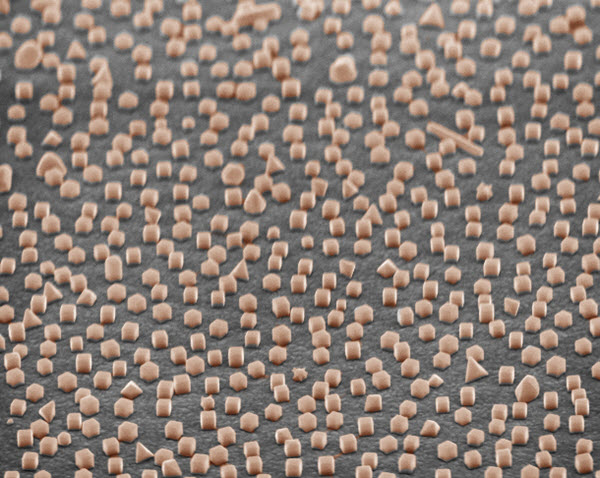













 . At this mass resolution, the Q Continuum run is currently the largest cosmology simulation available. It enables the construction of detailed synthetic sky catalogs, encompassing different modeling methodologies, including semi-analytic modeling and sub-halo abundance matching in a large, cosmological volume. Here we describe the simulation and outputs in detail and present first results for a range of cosmological statistics, such as mass power spectra, halo mass functions, and halo mass-concentration relations for different epochs. We also provide details on challenges connected to running a simulation on almost 90% of Titan, one of the fastest supercomputers in the world, including our usage of Titan’s GPU accelerators.
. At this mass resolution, the Q Continuum run is currently the largest cosmology simulation available. It enables the construction of detailed synthetic sky catalogs, encompassing different modeling methodologies, including semi-analytic modeling and sub-halo abundance matching in a large, cosmological volume. Here we describe the simulation and outputs in detail and present first results for a range of cosmological statistics, such as mass power spectra, halo mass functions, and halo mass-concentration relations for different epochs. We also provide details on challenges connected to running a simulation on almost 90% of Titan, one of the fastest supercomputers in the world, including our usage of Titan’s GPU accelerators.